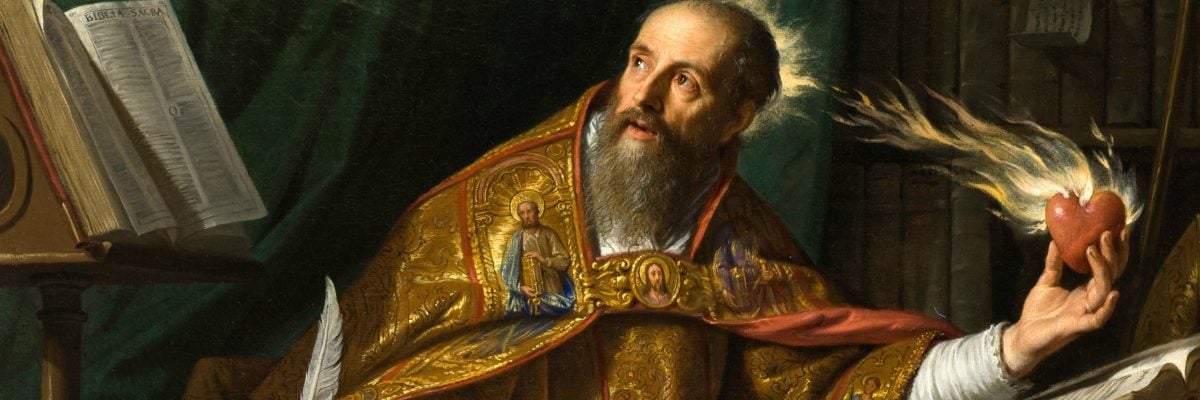
Today we celebrate the feast day of St. Augustine of Hippo (354-430), one of the four original Doctors of the Church. Pope Benedict XVI referred to him as the “greatest Father of the Latin Church,” and lists Augustine’s Confessions as the book (along with the Bible) that he would want if he were stranded on a desert island.
Protestants revere Augustine, too. R.C. Sproul said that “if there is any giant that stands out in the history of the Church as the man upon whose shoulders the whole history of theology stands, it is a man by the name of Aurelius Augustine, St. Augustine.” The nineteenth-century Anglican historian Philip Schaff called him as “a philosophical and theological genius of the first order, towering like a pyramid above his age, and looking down commandingly upon succeeding centuries.”
August isn’t just the month in which we remember Augustine. It’s also the month in which the Church has traditionally celebrated an obscure but fascinating event: the finding of the relics of St. Stephen, whose death in Acts 7:59-60 marks the first of history’s countless Christian martyrdoms.
At first glance, Stephen and Augustine seem unrelated. They lived and died on separate continents and in separate centuries. But they are connected in a fascinating way.
During Augustine’s lifetime around the year 410, Stephen’s relics were miraculously revealed in a dream to a priest named Lucian, who took this information to the patriarch of Jerusalem, John II, and together they unearthed three tombs. One of them had the inscription Cheliel—Stephen’s name in Syriac. Inside were the bones of the world’s first Christian martyr.
The whole thing may sound a bit farfetched. But the truth of the event is supported by two important witnesses: Augustine and his mentor St. Ambrose of Milan (340-397). How was the long-dead Ambrose an important witness to the truth of the event? Because something similar had happened to him years earlier.
Those who have read the Confessions may recall that Ambrose plays a pivotal role in the conversion of Augustine. In book V, Augustine refers to him as “Ambrose the bishop, known to the whole world as among the best of men.” From 379-386 he built the basilica that now bears his name, but he began it upon a condition: relics must be placed beneath the altar. Shortly thereafter, God revealed to him in a vision where he could find the relics of the martyrs Sts. Gervasius and Protasius. Those relics become occasions for a great many miracles. As Ambrose later recounted to his sister,
For not without reason do many call this the resurrection of the martyrs. I do not say whether they have risen for themselves, for us certainly the martyrs have risen. You know—nay, you have yourselves seen—that many are cleansed from evil spirits, that very many also, having touched with their hands the robe of the saints, are freed from those ailments which oppressed them; you see that the miracles of old time are renewed, when through the coming of the Lord Jesus grace was more largely shed forth upon the earth, and that many bodies are healed as it were by the shadow of the holy bodies. How many napkins are passed about! How many garments, laid upon the holy relics and endowed with healing power, are claimed! All are glad to touch even the outside thread, and whosoever touches will be made whole.
Augustine records this same phenomenon in book IX, chapter 7 of his Confessions, describing a case in which a blind man regained his sight after touching the saints’ relics. Lucian’s account is less fantastical when we realize that something remarkably similar was recorded halfway across the empire a few decades earlier… and that the authenticity of these relics was verified via a series of public miracles.
This brings us directly to the encounter between Augustine and the relics of St. Stephen. While Augustine was bishop of Hippo, Stephen’s relics were brought to town, and the results were incredible. Augustine recounts this in book XXII, chapter 8 of City of God, in his response to the objection that there aren’t miracles in the world any longer. His answer is that miracles do still occur, but they’re simply less well known. Among these he mentions miracles wrought by relics of the saints.
To support this claim, he recounts the aforementioned healing of the blind man (which he notes “was wrought at Milan when I was there”), among other miracles. He also testifies to the raising from the dead of a Spanish priest and several more miracles occurring in or around Hippo because of Stephen’s relics. He then goes on to add:
What am I to do? I am so pressed by the promise of finishing this work that I cannot record all the miracles I know…. [W]ere I to be silent of all others, and to record exclusively the miracles of healing which were wrought in the district of Calama and of Hippo by means of this martyr—I mean the most glorious Stephen—they would fill many volumes…
For when I saw, in our own times, frequent signs of the presence of divine powers similar to those which had been given of old, I desired that narratives might be written, judging that the multitude should not remain ignorant of these things. It is not yet two years since these relics were first brought to Hippo-regius, and… those [miracles] which have been published amount to almost seventy at the hour at which I write. But at Calama, where these relics have been for a longer time, and where more of the miracles were narrated for public information, there are incomparably more.
It’s easy to understand how a Protestant might revere Augustine while thinking him wrong on the topic of relics. But critically, it is not just that Augustine believed in relics and their miraculous powers—it’s that he and his mentor Ambrose both claimed to be eyewitnesses to fantastic miracles wrought by relics, in the diocese of which he was bishop.
This fact puts Protestants in a precarious position. Do they conclude that he and Ambrose were lying? Such a conclusion is hardly sustainable. Both of them are testifying to events that were too public and too well-documented to be the work of one man’s imagination. As St. Paul reminds King Arippa, “this was not done in a corner” (Acts 26:26).
Should Protestants conclude that Augustine was simply naive or delusional? That would greatly undermine his status as “a philosophical and theological genius of the first order” and the greatest theologian of the first millennium.
No, the only way to take Augustine seriously as a theologian is to take him seriously as a Christian witness, and that includes his witness to the miracles he personally observed brought about the relics of St. Stephen.
You can’t have Augustine without having a belief in relics.
This will make many Protestants uncomfortable. Aren’t relics superstitious? Don’t they take away from the very sovereignty of God that Augustine so passionately defends? To this objection, it’s best to let Augustine answer:
To what do these miracles witness, but to this faith which preaches Christ risen in the flesh, and ascended with the same into heaven? For the martyrs themselves were martyrs, that is to say, witnesses of this faith, drawing upon themselves by their testimony the hatred of the world, and conquering the world not by resisting it, but by dying. For this faith they died, and can now ask these benefits from the Lord in whose name they were slain.
It makes no difference, Augustine says, whether God works his miracles directly, or through the martyrs in heaven, or through holy men on earth, or through angels. God is still ultimately responsible for the miracle; “what is said to be done by the martyrs is done not by their operation, but only by their prayer and request.”
God chooses to work through the relics of the saints, it seems, because “these miracles attest this faith which preaches the resurrection of the flesh to eternal life.” Of course God could perform these miracles directly. But in choosing to work through the relics of the saints he demonstrates to us the reality of the promised resurrection.



